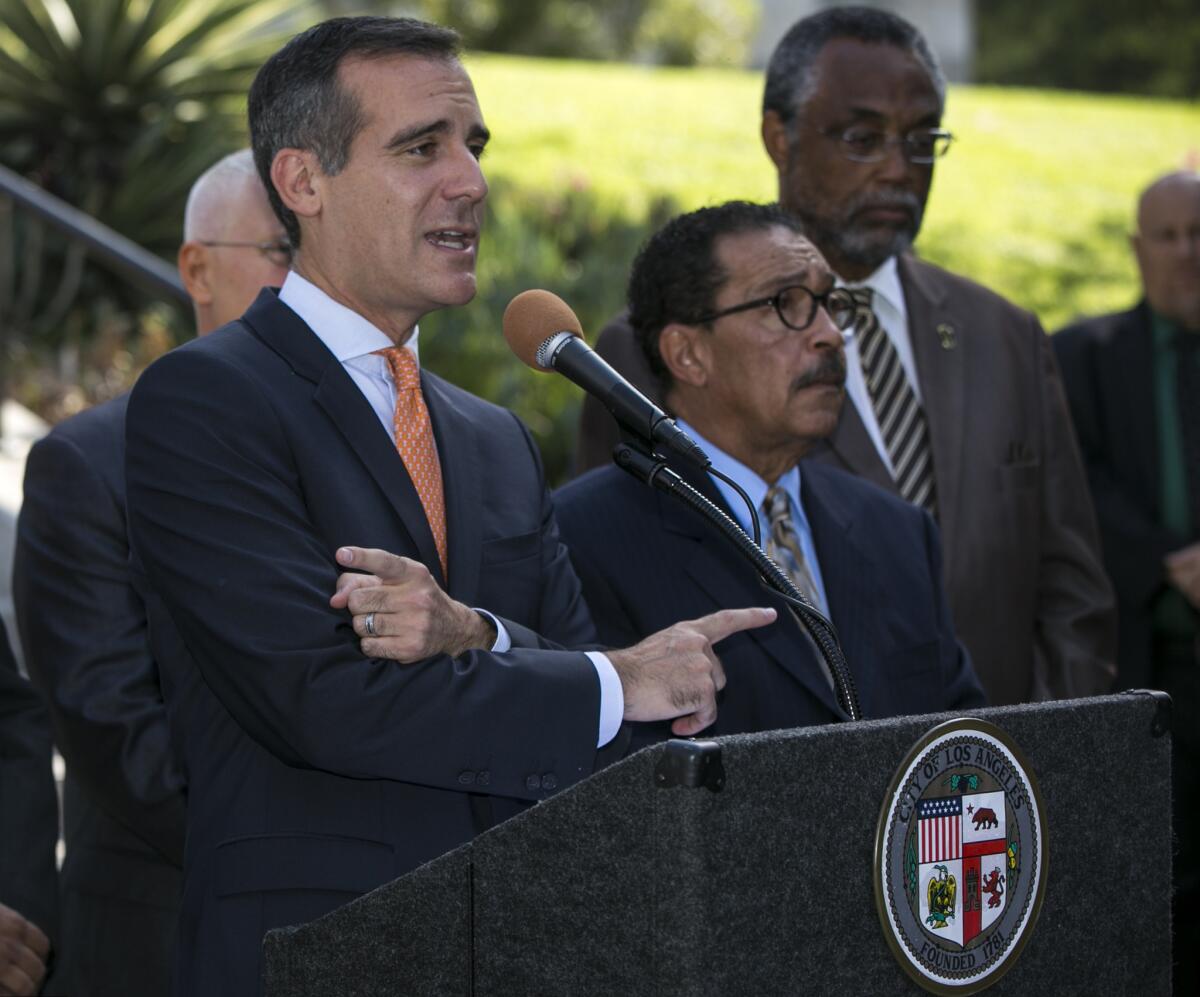Op-Ed: Affordable-housing problem lies, in part, with government

Mayor Eric Garcetti and Los Angeles City Council members announce a homelessness emergency plan on Sept. 22.
It was a depressingly familiar sight: Rattled government officials — enlightened progressives all — in a desirable coastal city declaring an emergency over runaway homelessness and chronically expensive housing.
Yes, that city was Los Angeles, where last week Mayor Eric Garcetti pledged to spend at least $100 million over the next year on housing and related services. But it was also Portland, Ore., where an exasperated Mayor Charlie Hales said, “We’ve tried slow-and-steady. We’ve tried by-the-book. It’s time to add the tools we currently lack.”
In New York, those tools include a rent freeze on qualifying leases and a near-doubling of the legal aid available for tenants trying to stave off eviction. In L.A., whatever plan emerges for spending that $100 million will surely emphasize city construction of affordable units and homeless shelters.
The preferred two-pronged housing approach in progressive America is government-owned real estate plus restrictions on private-sector developers. This strategy will probably make a bad problem worse, from San Francisco and Seattle to Washington and Boston.
But let’s just focus on California. Government exertions — and there have been plenty — have barely amounted to a rounding error in the total supply of housing stock. Since the mid-1980s, California’s various programs to subsidize, incentivize and mandate affordable housing have produced all of 7,000 units a year, “or about 5 percent of total public and private housing construction,” according to a May 2015 report by the California Legislative Analyst’s Office.
The LAO study, which should be required reading for anyone who seeks to make or influence housing policy in the Golden State, includes a recommendation that government recognize its own limitations when intervening in the lower-end residential real
estate market.
“The scale of these programs — even if greatly increased — could not meet the magnitude of new housing required,” it states. What’s needed are “broader changes that facilitate more private housing construction,” it says.
This latter bit is where progressives start whistling loudly and changing the subject to greedy developers and the dastardly 1%. After all, demonizing Donald Sterling and Geoffrey Palmer makes for punchier news conferences than easing up on zoning restrictions and speeding up approval processes.
But if policymakers and activists are serious about getting housing prices down, they need to acknowledge their own role in bidding the market up. Prices — even in housing — are a function of supply and demand, and politicians along California’s coast have been systematically pinching supply for decades.
For example: “Development fees — charges levied on builders as a condition of development — are higher in California than the rest of the country,” the LAO report notes (and the difference is substantial: $22,000 versus $6,000, on average). It takes seven months to get a building permit in coastal areas (compared with 4 1/2 months nationally), 12 months to get a rezoning variance (compared with 9 months), and projects subject to the state’s intensive Environmental Impact Review process take an average of 21/2 years to approve.
When you make a good more expensive to produce, you’re going to get less of it. Housing stock in the L.A. metro area grew by just 20% between 1980 and 2010, according to the LAO report, compared with 54% on average in other American metropolitan areas. When you add statutory limits to housing growth, a California coastal favorite, the fog behind the state’s persistently high housing prices lifts still further.
This government squeeze is not limited to the creation of housing in the first place, but also to what owners can do with their property. The L.A. City Council has in recent years placed restrictions on landlords wishing to change their rental units into condominiums, homeowners wanting to tear down their own houses and replace them with mansions, and renovators whose add-on plans create an
extra-large footprint.
The mother of all supply-crimping landlord restrictions, of course, is rent stabilization. More than four decades after Richard Nixon’s disastrous wage and price controls, government-imposed price-fixing is almost universally understood to be a terrible idea. Yet somehow policymakers keep telling themselves that the economic laws don’t apply to the roof over your head. As one Nobel Prize-winning economist wrote in 2000, “The analysis of rent control is among the best-understood issues in all of economics, and — among economists, anyway — one of the least controversial. In 1992, a poll of the American Economic Assn. found 93% of its members agreeing that ‘a ceiling on rents reduces the quality and quantity of housing.’”
That economist was no free-market extremist. It was Paul Krugman.
So by all means, let’s declare a state of emergency on affordable housing. But before throwing more good taxpayer money after bad construction projects, let’s examine existing policy and practices that the government’s own analysts conclude are not working. Then maybe we won’t have to live through another round of emergency measures five years from now.
Matt Welch is editor in chief of Reason.
Follow the Opinion section on Twitter @latimesopinion and Facebook
More to Read
A cure for the common opinion
Get thought-provoking perspectives with our weekly newsletter.
You may occasionally receive promotional content from the Los Angeles Times.










